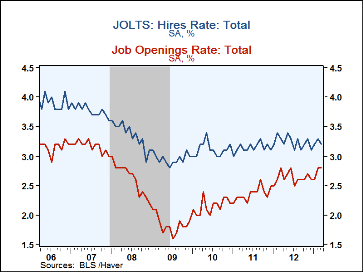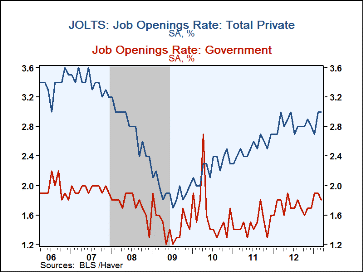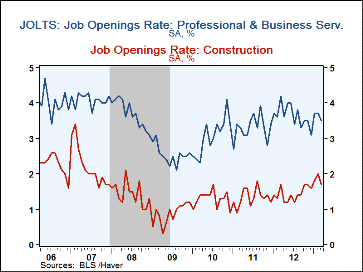 Global| May 07 2013
Global| May 07 2013U.S. JOLTS: Job Openings Rate Remains Firm But Hiring Lags
by:Tom Moeller
|in:Economy in Brief
Summary
The Bureau of Labor Statistics reported in its Job Openings & Labor Turnover Survey (JOLTS) that the March job openings rate held m/m at 2.8%. The latest remained the highest since June of last year and equaled the recovery high. The [...]
The Bureau of Labor Statistics reported in its Job Openings & Labor Turnover Survey (JOLTS) that the March job openings rate held m/m at 2.8%. The latest remained the highest since June of last year and equaled the recovery high. The job openings rate is the number of job openings on the last business day of the month as a percent of total employment plus job openings. The actual number of job openings fell 1.4% m/m (-0.1% y/y) and backed away from the recovery high.
The private-sector job openings rate held m/m at its recovery high of 3.0%, double the recession low of 1.7%. The job openings rate in leisure & hospitality rose to a cycle-high 3.6%. The job openings rate in professional & business services fell to 3.5% and in health care and social services it slipped to 3.2%. The rate in manufacturing ticked lower to 2.1% while in construction it declined to 1.7%. The job openings rate in government fell m/m to 1.8% but still was up from the 2011 low of 1.3%.
The hires rate slipped back to 3.2% and continued its erratic sideways move since 2011. The hires rate is the number of hires during the month divided by employment. The hires rate in the private sector fell to 3.5% while the government's rate slipped to 1.3%. In construction the hiring rate was down m/m to a still-firm 5.8%. In professional & business services the hires rate inched up to 4.7%, though that was down sharply from the cycle high of 5.5%. In leisure & hospitality, the hiring rate remained a strong 5.4% while in education & health services the rate ticked up to 2.5%. The factory sector hires rate slipped to just 1.7%.
Overall hires in the private sector declined 4.0% y/y as factory sector hires fell by nearly one-quarter y/y. Trade, transportation & utilities hiring fell 5.1% y/y while professional & business services hires fell 3.0% versus last year. Government sector hiring fell 2.7% y/y but education & health services hires ticked up 0.2% against March 2012.
The job separations rate remained at 3.1% for the third month. Moreover, the actual number of separations inched up just 0.8% y/y. Separations include quits, layoffs, discharges, and other separations as well as retirements. The layoff & discharge rate nudged up again m/m to 1.3%. The private sector layoff rate ticked up to a still-low 1.4% and in government it held at 0.5%.
The JOLTS survey dates only to December 2000 and the figures are available in Haver's USECON database.
| JOLTS (Job Openings & Labor Turnover Survey) | Mar | Feb | Jan | Mar'12 | 2012 | 2011 | 2010 | |
|---|---|---|---|---|---|---|---|---|
| Job Openings, Total | ||||||||
| Rate (%) | 2.8 | 2.8 | 2.6 | 2.8 | 2.6 | 2.6 | 2.2 | |
| Total (000s) | 3,844 | 3,899 | 3,611 | 3,848 | 3,617 | 3,540 | 2,902 | |
| Hires, Total | ||||||||
| Rate (%) | 3.2 | 3.3 | 3.2 | 3.3 | 38.8 | 38.0 | 37.4 | |
| Total (000s) | 4,259 | 4,451 | 4,298 | 4,435 | 51,811 | 50,006 | 48,647 | |
| Layoffs & Discharges, Total | ||||||||
| Rate (%) | 1.3 | 1.2 | 1.1 | 1.3 | 15.6 | 15.6 | 16.7 | |
| Total (000s) | 1,693 | 1,572 | 1,520 | 1,762 | 20,621 | 20,678 | 21,737 | |
Tom Moeller
AuthorMore in Author Profile »Prior to joining Haver Analytics in 2000, Mr. Moeller worked as the Economist at Chancellor Capital Management from 1985 to 1999. There, he developed comprehensive economic forecasts and interpreted economic data for equity and fixed income portfolio managers. Also at Chancellor, Mr. Moeller worked as an equity analyst and was responsible for researching and rating companies in the economically sensitive automobile and housing industries for investment in Chancellor’s equity portfolio. Prior to joining Chancellor, Mr. Moeller was an Economist at Citibank from 1979 to 1984. He also analyzed pricing behavior in the metals industry for the Council on Wage and Price Stability in Washington, D.C. In 1999, Mr. Moeller received the award for most accurate forecast from the Forecasters' Club of New York. From 1990 to 1992 he was President of the New York Association for Business Economists. Mr. Moeller earned an M.B.A. in Finance from Fordham University, where he graduated in 1987. He holds a Bachelor of Arts in Economics from George Washington University.










